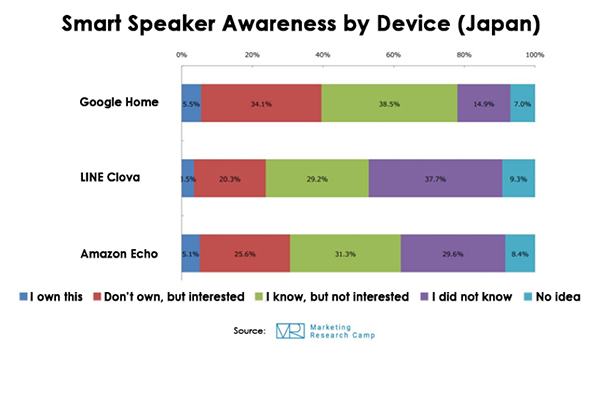The Japanese Smart Speaker Market
Although the arrival of the smart speaker in Japan was later compared to other markets, user adoption and interest in these products have increased noticeably in 2018. User adoption and awareness are also expected to increase as more and more brands create products and services to complement the three major AI platforms: Amazon Alexa, Google Assistant/Home, and LINE Clova.
Purchase Rates and Awareness on the Rise in Japan
In the United States, it is quite common to have a smart speaker in the house as evidenced by the 20%+ ownership rate. Smart speakers were finally introduced to Japan in the autumn of 2017, and therefore the ownership numbers are lower. According to Marketing Research Camp by the end of 2017, the smart speaker ownership rate among those aged 15-69 was 4.5%, but the same research conducted two months later in February of 2018 yielded an increase to 5.7% showing continued segment growth.
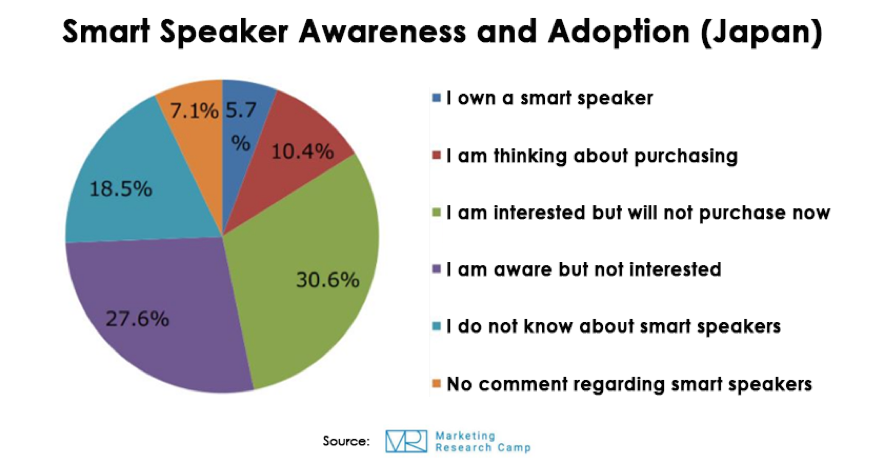
Since the three main players (Google, Amazon, LINE) all launched their smart speakers in October 2017, awareness reached 70% of the online population and is estimated to be now at 80-90%. The following graph shows how users interact with their smart speakers and the frequency of those actions. Similar to the U.S., music listening, news, timers and alarms are top use cases. Notably, shopping is also popular with 17.3% of Japanese smart speaker owners saying they use the devices very often for the task.
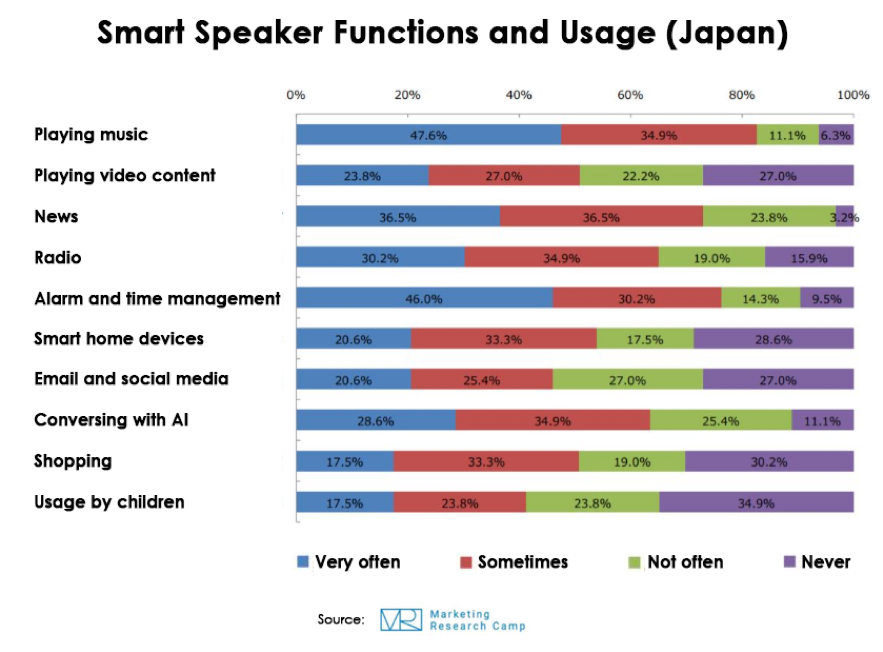
Gradual Warming to Smart Speakers Culturally
In the United States, it took about 3 years to reach 20% adoption. It will also take time in Japan for the various platforms to work out the complexities of the language along with breaking down cultural and personality barriers when using smart speakers. As a culture, the Japanese shy away from speaking in front of others, and apparently shy away from speaking to a machine as well.
According to a 2017 voice search study by KDDI, it found that 70% of users said, “It is embarrassing to voice search in front of others.” In addition, when operating smart devices in the home by voice, 40% of respondents say “I only do so with nobody in the house.”
The Japanese culture is known to be slow to adapt to trends and the need to say “Alexa” or “OK Google” creates a temporary barrier to adoption. However, the younger generations offer great hope for massive adoption as Google and LINE spend heavily on television ads, and now perhaps almost everybody has heard of the wake words “Alexa”, “Hey, Google”, and “Clova”. It is almost certain that adoption rates will increase in Japan as a result of this advertising.
The 3 Smart Speaker Giants: Google, Amazon, LINE
Unlike in the U.S., which has many third-party manufacturers, Japan only has Google, Amazon and LINE as the largest players in the smart speaker market.
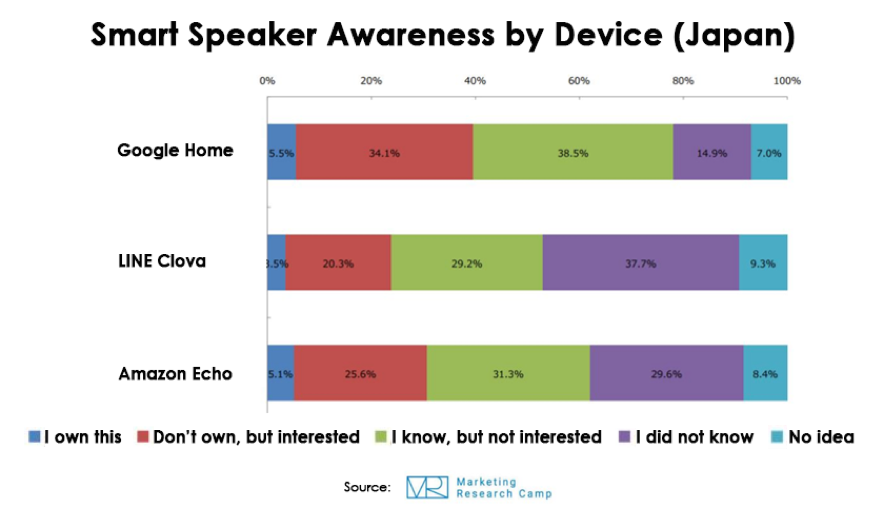
LINE clearly has family and kids as their target customers, and excels with their line of four speaker models that read books to kids and allow for calls to and from their smartphone app. The LINE Friends smart speakers have proven to be a hit, as the Doraemon speaker acts as a toy and an AI assistant for kids.
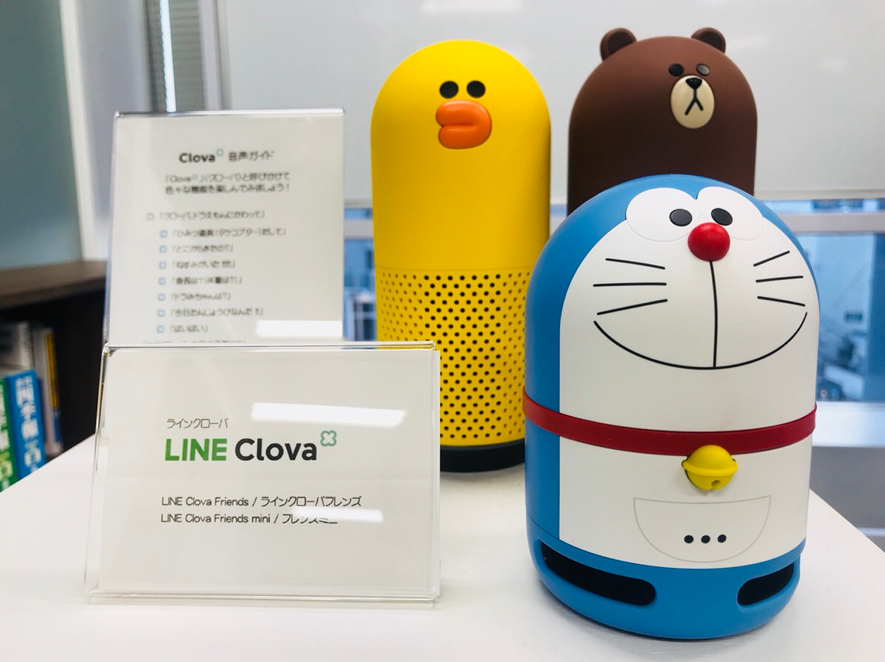
However, the Clova platform’s weakness is its complete lack of third-party skills and connectivity to smart home devices. Alexa has over 1,100 skills in Japanese, and Google Assistant has roughly 470 actions. LINE has recently opened up its platform to developers and is looking to increase third party developer support. The company has announced an annual competition with a 10,000,000 JPY ($90,000 USD) grand prize.
Brands and Corporations Jumping in on Development
With the arrival of the Echo Spot in July, developers large and small have shown increased interest in developing for voice assistants and skills with display features. Recent hits for the Echo Spot include a recipe skill and a karaoke skill. In addition, a domestic no-coding-required skill development tool called NOID will be released within August, which is certain to increase the number of skills available for Alexa in the coming months.
The Outlook on Smart Speakers and Voice Products in Japan
The outlook for smart speakers is promising as large electronics manufacturers like Sony and Panasonic are developing smart home devices and gadgets with voice user interfaces. Real estate companies are also packaging their homes with IoT devices and voice products. In research conducted by Video Research Interactive in May of 2018, respondents were asked which electronic device they would like to purchase next, and 9.4% of those said that they would like a smart speaker.
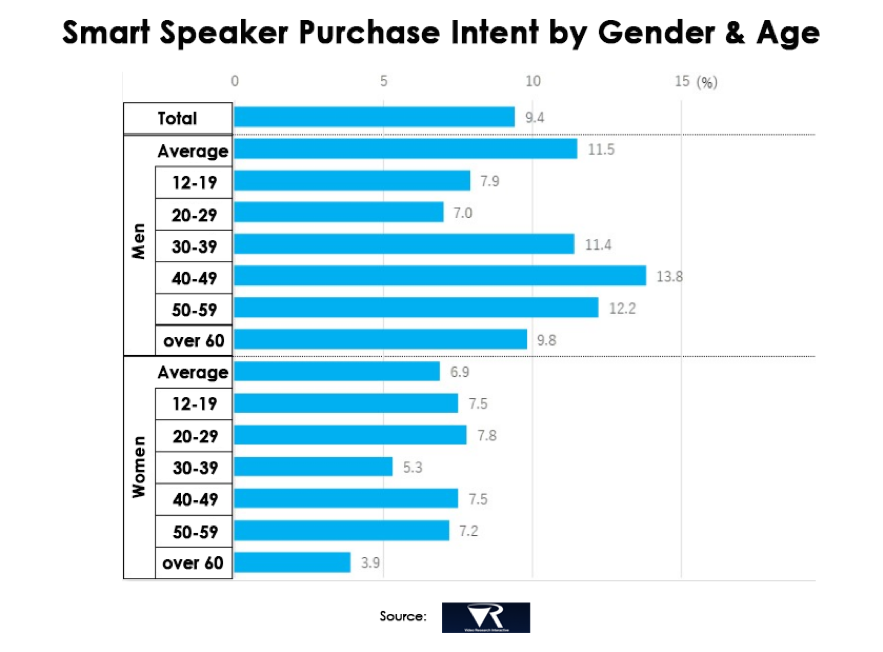
Voice and AI in Japan
In regards to artificial intelligence, based on a survey of the AI market conducted by Fuji Keizai, the future does look very bright. Based on 2016 data of what was a $2.6 billion market split among AI services, applications, and platforms, the value of the AI market is expected to experience major growth and general adoption by 2021. And by 2030, the domestic AI market size is estimated to be worth $19 billion, with AI to be prominently used in services commonly used in Japan. Data from Kyodo News shows that the government’s draft budget for AI-related spending in 2018 to be about $720 million, which is small compared to the 5-6 times larger budgets of China and the US, but still enormous.
Where American companies like Amazon and Google excel is that at the very instant they start charging you for an Echo or Home, the product itself is already equipped with a sufficient blend of functional software and hardware. And once the foundation is solid, a whole ecosystem springs up to allow both users and third-party developers to exist and continuously create value for the platform.
With numerous talented domestic companies doing the heavy lifting behind the scenes in the voice field, there is an absolute need for large players like Amazon and Google to continue pushing their products to drive consumer adoption. An exciting new company called Voicy is also leveraging the recent surging popularity of voice products. Voicy offers its own app for users to listen to hundreds of online personalities in addition to their voice user interface (VUI) development and consulting services for all the major AI smart speaker platforms.
It is true that the land of the rising sun is lagging when it comes to smart speaker adoption but he Japanese culture is adaptive. Once something hits the mainstream, everybody follows, and companies large and small will improve and develop unique products to fit the trend du jour. This has always been true of the Japanese culture. Ideas are brought in and improved, and then products make their way to the market after heavy localization and customization. The data show that smart speakers are falling into a similar pattern.
About the Authors: Simon Zhang and Koji Itoyama are teammates at Smartio.life


